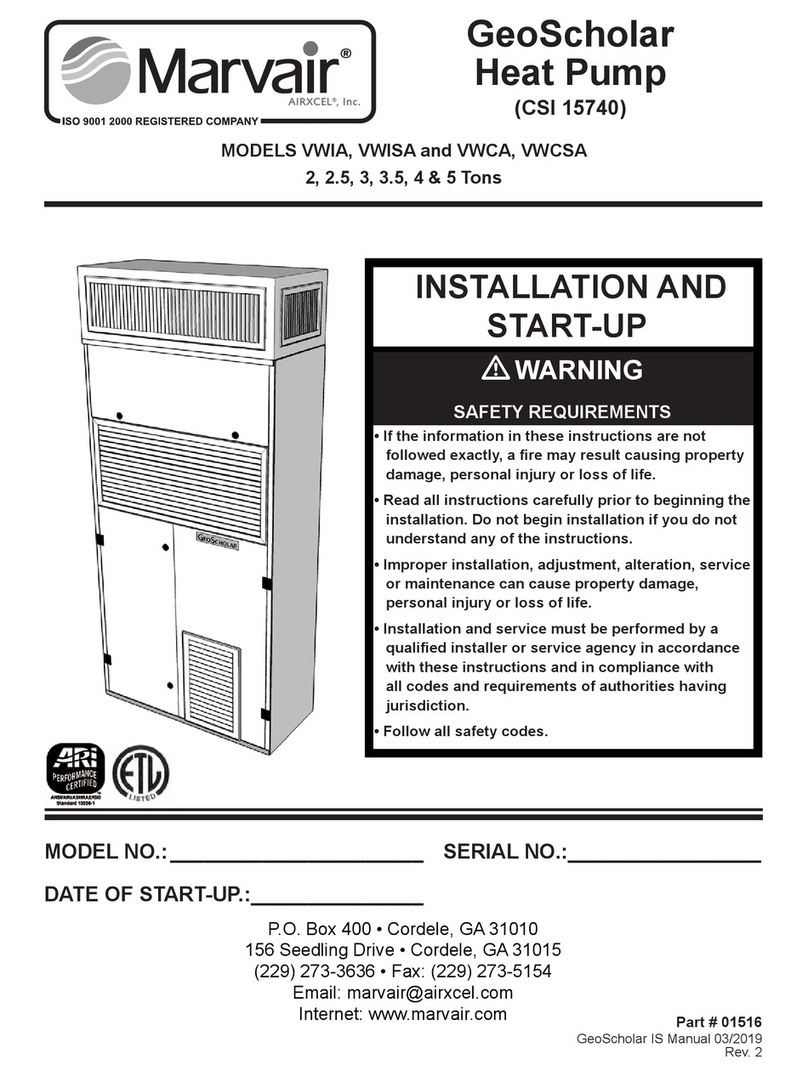
10
Marvair 8AA1024H-1060H & 8AA2024H-2060H I&O Manual 06/2023 Rev.2
construction and operating cost while ventilating the classroom to ASHRAE 62-1999 requirements. The
use of the GreenWheel ERV reduces the energy load of the outside air. Exhausting stale, inside air keeps
indoor pollutants and harmful gases to a minimum. The Marvair GreenWheel ERV has been tested and
certified according to ARI Standard 1060.
How It Works: During the summer, cool dry air from the classroom is exhausted through the GreenWheel
ERV to the outside. As the air passes through the rotating wheel, the desiccant becomes cooler and
drier. Simultaneously, hot humid air is being pulled across the rotating wheel. The cool, dry desiccant
absorbs moisture and heat from the incoming air. The cooler, drier air is mixed with the return air from
the classroom and distributed throughout the room.
In the winter, warm moist air is exhausted through the GreenWheel ERV to the outside. As the air passes
through the rotating wheel, the desiccant becomes warmer and absorbs moisture. Simultaneously, cold
dry air is being pulled across the rotating wheel. The cold, dry air absorbs heat and moisture from the
desiccant. The warmed air is mixed with the return air from the classroom and distributed throughout
the room.
Quality Components: The GreenWheel ERV Ventilation package consists of the GreenWheel cassette, an
incoming air blower, an exhaust air blower, an air filter for the incoming air and one fan speed controller
that controls the speed of both blower motors simultaneously. As an option, a second fan speed controller
can be factory installed for independent control of the exhaust air motor and positive pressurization of
the classroom. Also, an optional filter on the exhaust air is available on selected models. Please consult
your Marvair representative for details. The two blowers simultaneously pull fresh air from outside and
exhaust air from the classroom through the rotating wheel. The air streams are separated by an insulated
partition so that the incoming fresh air is not mixed with the exhaust air. Two variable speed blowers
ensure that up to 450 CFM of outside air can be brought into the room and the indoor air is properly
exhausted. Variable speed blowers permit that the desired quantity of outside air is delivered into the
room. Optional independent exhaust air blower control allows positive pressurization of the classroom,
i.e., more outside air can be introduced through the GreenWheel ERV than is exhausted.
Configuration “N”: Barometric Fresh Air Damper (Standard)
Barometric damper capable of up to 15% of rated airflow of outside air; field adjustable, no pressure relief.
Hot Gas Reheat (HGR) Dehumidification Mode (Special Option “G”)
When the HGR is in the dehumidification mode, the hot gas reheat (HGR) coil is energized. The cooled,
dehumidified air exits the evaporator coil and is blown through the HGR coil. This coil is sized to the
sensible capacity of the unit. The heat in the HGR coil is transferred to the air stream. The use of the HGR
coil allows the indoor humidity of the classroom to be maintained at or below a certain set humidity set
point without over cooling the classroom. These units can not add humidity to the classroom.
The operation of the HGR coil is controlled by a humidity controller. If the humidity rises above the set
point on the controller and the temperature in the classroom is satisfied, both mechanical cooling and
the HGR coil operate to temper the air and lower the humidity. If the temperature in the classroom rises
above or falls below the set point of thermostat and the unit is operating in the dehumidification mode,
the need for cooling or heating will override the call for dehumidification and the HGR coil is disengaged
until the thermostat is satisfied. This assures the classroom temperature is maintained as first priority
and humidity control is second.
The humidity controller or BAS control is required for proper operation of the HGR coil.


































